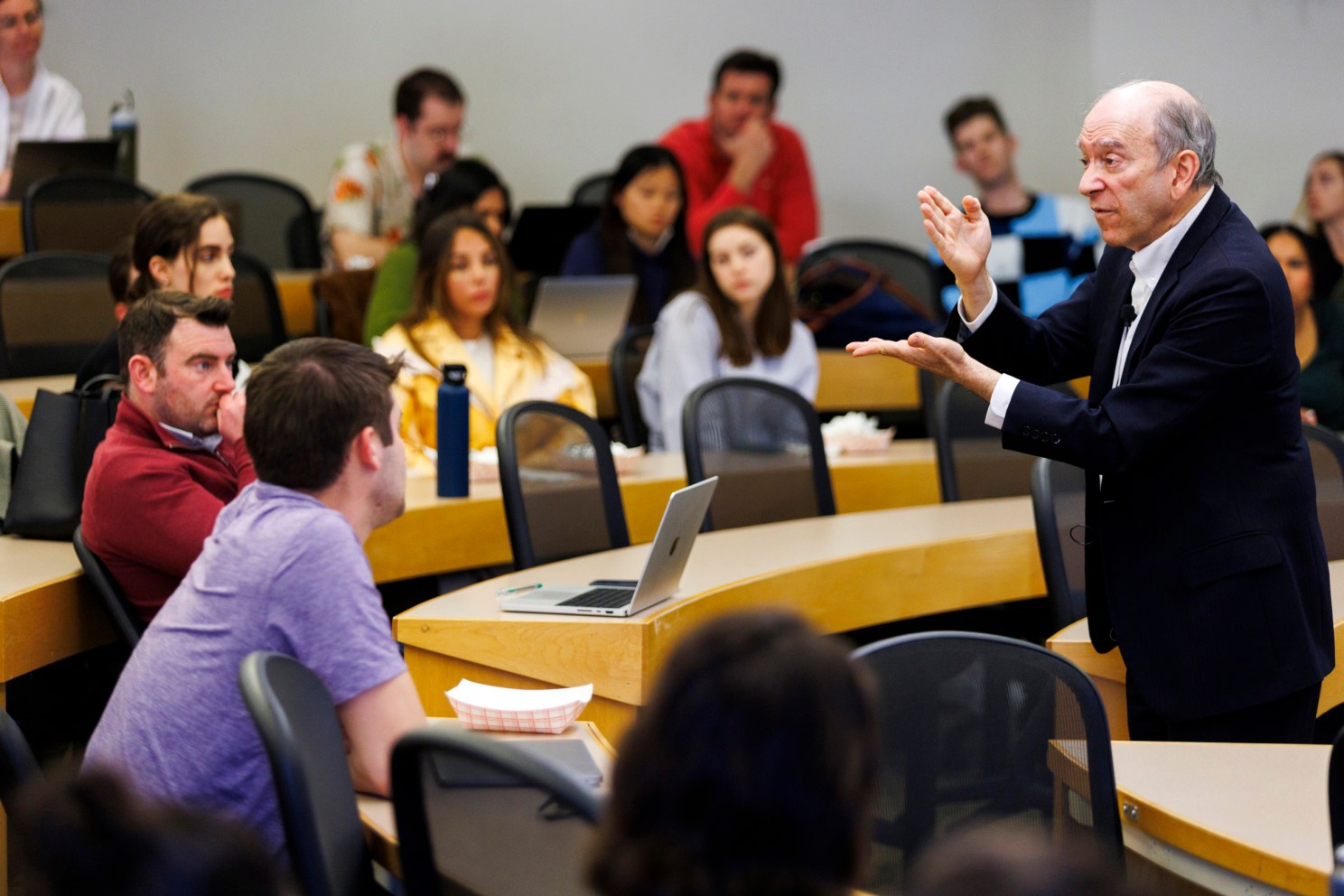Environmental law expert voices warning over Supreme Court

Harvard Law School Professor Richard Lazarus talks to students about the conservatism of the current Supreme Court and its impact on environmental law.
Stephanie Mitchell/Harvard Staff Photographer
Richard Lazarus sees conservative majority as threat to protections developed over past half century
The current conservative bent of the U.S. Supreme Court threatens to erode environmental law and reverse a series of important protections secured over the past 50 years, Richard Lazarus, one of the nation’s foremost experts on environmental law, said Tuesday afternoon at a Harvard Law School event.
In what he warned would be an “unhappy talk,” Lazarus, the Charles Stebbins Fairchild Professor of Law, offered a chronology of shifts in the court and environmental law over the last half century.
“Everything environmental law has accomplished over the last sort of 50 years is just extraordinary,” said Lazarus, during a talk hosted by the Environmental & Energy Law Program and Emmett Environmental Law & Policy Clinic. “It has been an incredible legal revolution in this country and has managed to bring down an enormous amount of air, water, and land pollution, while at the same time not leaving the kind of devastating economic effects that people thought we might have.”
The appointments of Neil Gorsuch, J.D. ’91, Brett Kavanaugh, and Amy Coney Barrett to the Supreme Court by former President Donald Trump has given conservative justices a majority in the court, a situation that doesn’t bode well for the future of environmental legislation, said Lazarus.
“We have three nominees to the court during the Trump administration who are very conservative individuals,” he said. “And with their votes, we’ve now had, in a very short period of time, a series of rulings that are very portentous to the future of environmental law.”
Lazarus cited two recent cases that represent a reversal of protections: the 2022 Clean Power Plan case, which limited the Environmental Protection Agency’s authority to regulate power plant emissions, and the 2023 Sackett v. EPA case, where the court dramatically curtailed the Clean Water Act of 1972, which governs water pollution.
This year, two cases before the court seek to overrule the 1984 decision known as the “Chevron doctrine,” which recognizes the decision-making authority of federal regulatory agencies. The doctrine has been the bedrock of administrative laws for decades, and if it is overturned, the ruling could significantly restrain the power of regulators and weaken administrative and environmental laws.
In Lazarus’ view, the Supreme Court had been “relatively moderate” on environmental issues until 2020. In an overview of the court spanning 50 years, Lazarus said pastRepublican appointees made “fairly balanced” decisions with a “win some, lose some” philosophy.
He pointed to the roles of Justices Harry Blackmun (1970-1994), John Paul Stevens (1975-2010), and David Souter (1990-2009), who, despite being Republican appointees, turned out to be “sensitive to environmental concerns,” and aware of the need to tackle some issues in environmental law while balancing them with property clause protections, administrative law, and deference to agencies.
Republican nominees Justice Sandra Day O’Connor (1981-2006) and Anthony Kennedy (1988-2018) shared their colleagues’ concerns, and there were occasions when they joined more liberal justices against conservative colleagues in key decisions.
“Justices O’Connor and Kennedy were deeply concerned about government overreaching, but they were very fact-dependent and worried about fairness,” Lazarus said. “Justice O’Connor particularly worried a lot about fairness, whether something made sense or not, and there were times when she would vote for the property owner. Justice Kennedy was very different from O’Connor, but as someone from California, he understood the time and space issues inherent in environmental cases and how land could be fragile.”
Another source of concern for Lazarus, who has represented the federal, state, and local governments, and environmental groups before the Supreme Court in 40 cases, is the fact that Congress has not passed a significant environmental law since 1990.
“Paralyzing partisanship has shut down Congress in 1990 for most things environmental,” said Lazarus, who teaches environmental law, natural resources law, Supreme Court advocacy, and torts. “During the 1970s and the 1980s, there was unbelievable bipartisanship on environmental law … Since 1990, we’ve had complete gridlock in Congress.”
The need for new environmental legislation and new statutory language is urgent, Lazarus said. The Clean Air Act has not been amended since 1990, the Water Quality Act since 1987, the Hazardous and Solid Waste Amendments since 1984, and the Endangered Species Act since 1973.
Making environmental legislation is hard, concedes Lazarus, given the complexities of the issues. Lawmakers must deal with regulations whose causes and effects are spread out over long stretches of time and geography. But the consequences of inaction can be tragic.
“If you wait too long, a species is gone,” said Lazarus. “You wait too long, and the glaciers melt. If you wait too long, then the ocean currents change direction.
“We have problems that are massive, like climate change,” he said. “And the clock is ticking at the same time. The longer you wait, the exponentially harder it is to do anything about it. The potential for catastrophic effects happening with irreversible effects looms larger every year.”




